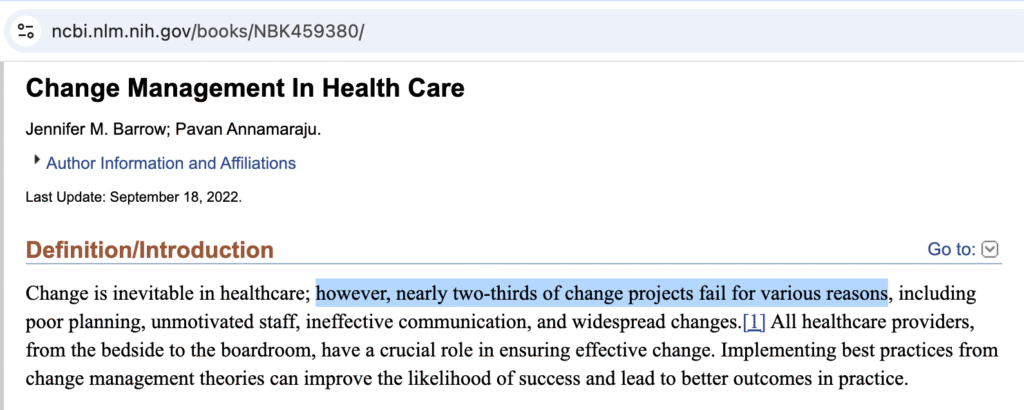The often-quoted claim that “70% of change initiatives fail” has become a cornerstone of modern change management conversations. This statistic is cited by consultants, leaders, and workshop slides with a kind of unquestioned authority.
But is it true?
In a time when organisations are under constant pressure to evolve—through digital transformation, restructuring, regulatory shifts, or culture change— understanding what makes change succeed or fail is more important than ever.
This article critically examines the origins of the 70% failure claim, reviews sector-specific data, draws on practitioner insight, and outlines what organisations can do to lead change that truly sticks.
The 70% Failure Claim: Fact or Convenient Myth?

The “70% failure rate” lacks consistent empirical backing. It originates from early observations by consultants like Hammer & Champy in the 1990s during business process reengineering. Later, authors like Beer & Nohria popularised the idea without offering detailed research evidence.
These figures were echoed in consulting presentations and business articles, but few of them were supported by peer-reviewed studies. In many cases, the definition of “failure” was ambiguous—was it a missed deadline, a failed rollout, or a loss in morale?
The number persisted, not because it was verified, but because it resonated.
What the Research Actually Says
Academic reviews, such as Hughes (2011), have questioned the legitimacy of the 70% claim. Hughes found that while the figure was widely cited, there was no single, reliable source underpinning it.
In practice, outcomes fall along a continuum. Not just pass or fail.
According to McKinsey’s global surveys, 30–40% of change efforts are considered fully successful, while only 10% are complete failures. The rest fall into the “partially met expectations” category.
IBM’s Making Change Work study (accessible via this PDF) reports that 41% of projects met their stated objectives, while 59% missed at least one goal—again illustrating that “failure” is rarely black and white.
Why This Myth Persists in Organisations
The stickiness of the 70% failure myth can be attributed to a few psychological and systemic factors:
- Confirmation bias: Leaders who’ve witnessed disappointing change efforts are more likely to believe the statistic without questioning its origin.
- Repetition in boardrooms: Because the stat is easy to remember and dramatic, it’s often repeated in PowerPoint decks—giving it a false sense of credibility.
- Fear as a motivator: Consultants sometimes use it to create urgency, prompting leaders to invest in external support.
The danger, however, is that this myth can discourage innovation, reinforce resistance, and lower expectations before a change initiative even begins.
Change Success Rates by Sectors
Based on recent research and analysis, here’s how change initiatives perform across selected sectors:
| Sector | Estimated Success Rate | Common Challenges | Source |
| Healthcare | Highly variable – often partial results | Leadership misalignment, inconsistent frontline engagement | NCBI / Institute of Medicine |
| Technology / Digital | 30–40% meet full goals | Lack of vision, slow execution, resistance to change | Mooncamp Blog |
| Public Sector-IT | 24% exceeded timeline 18-24% exceeded budget. | Bureaucracy, shifting mandates, project complexity | arXiv Research |
| All Industries (average) | ~30% succeed fully | Lack of sponsorship, poor communication, unclear metrics | McKinsey Transformation Report |

Fig 1. Success Rate is 1/3 in healthcare sector

Fig 2. Success Rate for Digital Transformation in 2021

Fig 3. Exceeding budgets and timeline.

Fig 4. Success Rate across all industries in 2021
Practitioner Insight: Why Perception Shapes Success
At Deep Impact, we’ve worked with leadership teams in engineering, IT, healthcare, and government organisations—and one theme recurs:
Perceptions of failure are often rooted in leadership misalignment, not poor execution.
In large, matrixed environments, each unit or function uses different KPIs. If there’s no agreed definition of success, even well-performing initiatives can be seen as “under-delivering.”
Our clients frequently report paraphrased feedback from the ground like:
- “We didn’t hear the vision again after launch.”
- “Senior leaders stopped showing up.”
Even when the change framework is sound, silence from leadership can deflate morale and signal a loss of priority. Success isn’t just measured by metrics—it’s also felt by the people doing the work.
Why Partial Success Still Counts
Too often, change is labelled as “failed” when it didn’t meet 100% of its objectives. But that standard is unrealistic.
Think of a digital transformation project that:
- Missed its original 12-month timeline by 3 months,
- Was 10% over budget,
- But increased adoption rates by 60% and unlocked major efficiency. Was it a failure? Not really.
Leaders must reframe success from perfection to measurable progress with strategic value.
Using binary labels like “success” or “failure” ignores learning curves, culture shifts, and behavioural change, which often take longer than technical implementation.
How to Increase the Success of Change Initiatives
Research and real-world experience point to the following best practices:
1. Secure Committed and Visible Leadership
Executive sponsors must do more than sign off—they need to model the change, communicate frequently, and address resistance head-on.
2. Align on Shared Success Metrics
Before launching, cross-functional leaders must agree on 3–5 clear outcomes (the lesser the better). This prevents confusion about whether progress is being made.
3. Communicate Early and Often
Beyond kickoff emails, successful efforts include regular updates, town halls, and storytelling about impact.
4. Co-Create with Employees
People support what they help build. Involve representatives from each stakeholder group in design and feedback loops.
5. Build Middle Management Capability
Middle managers are often the most critical—but least prepared—group during change. Equip them with coaching, messaging, and tools.
6. Celebrate Progress and Sustain Energy
Mark early wins. Then sustain energy by recognising champions, sharing testimonials, and embedding the new behaviours into reviews or KPIs.
You might also like: Organizational Change and Change Management Basics
Frequently Asked Questions (FAQs)
Is the 70% figure totally false?
It’s not that the number was made up—but it’s not grounded in consistent, peer-reviewed data. It’s better viewed as a myth that oversimplifies complex outcomes.
What’s the biggest reason change efforts struggle?
Most research points to people-related issues: miscommunication, lack of buy-in, unclear purpose, or change fatigue—not technical flaws.
What’s a reasonable success benchmark?
Aim for 80% of key milestones achieved and positive shifts in engagement. Full perfection is rare—but measurable, visible progress is achievable.
How do I position change internally without fear tactics?
Focus on possibility and empowerment. Use data to create urgency, but invite collaboration. Emphasise shared success, not shame.
Conclusion
The belief that “70% of change initiatives fail” is a powerful narrative—but an oversimplified one. While many efforts underperform, most deliver some value, and many succeed when led with clarity, commitment, and collaboration.
Organisations that realign leadership, communicate transparently, and actively engage people are not only debunking the myth—they’re reshaping the future of change itself.
Change doesn’t fail by default—it fails by design. Let’s design better.




